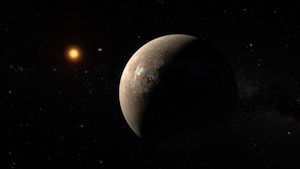A new earth-like planet discovered

There’s exciting news in astronomy. A new earth-like exoplanet named “Proxima b” has been discovered in space, and it couldn’t be any closer. It orbits our nearest neighbor in interstellar space, a small star called Proxima Centauri, only 4.2 light years away from our own solar system. It’s part of a trinary star system with two other well-known stars, Alpha Centauri A & B.
The planet is about 1.3 times larger than our own earth, and there’s a good chance it’s a rocky planet like our own. It also orbits in the so-called “goldilocks zone,” which means, like earth, it’s at the right distance from it’s star to maintain liquid water on its surface, increasing the chances that it could support life as we know it.
However, there’s a catch. Proxima Centauri is a red dwarf, which means it’s a tiny star, closer to the size of the planet jupiter than our own sun, so it generates only a small fraction of our sun’s energy, including visible light. In fact, most of the radiant energy that reaches the surface is in the infra red band, below our ability to detect visually. If plants capable of photosynthesis grew on this world, they would likely be black in color, in order to absorb all possible light under a dim red sky.
And due to the much lower energy output of Proxima Centauri, its goldilocks zone is much closer, meaning that Proxima b is so close to the star that it completes an orbit every 11 days. That contrasts sharply with the earth’s approximate 365 day orbit. And since the planet is so close to the star, it’s tidally locked, the way our own moon is as it orbits the earth.
That means that one side always faces the star, and the other side always faces away from the star, just like our moon. This creates a tremendous difference in temperature, and probably drives tremendously strong planet-wide winds (assuming the planet has an appreciable atmosphere.) Also, the planets closeness to its star means that it’s exposed to lots of x-ray radiation, which could be deleterious for life as we know it.
So the verdict’s still out on this curious earth-like world. It’s bound to be an absolutely fascinating place to visit, but is it teaming with life, like our earth? Its size, probable composition, and position within its star’s goldilocks zone are encouraging, but the tidal lock, and likely x-ray bombardment, are discouraging. And we don’t know about it’s atmosphere, and whether or not it harbors oceans of liquid water, thought to be essential for life as we know it to develop and thrive. Clearly much more study and observation is necessary over the next few decades to help answer these very important questions.
And there’s a truly exciting prospect on the horizon–the very real possibility of sending small smartphone-sized probes to Proxima b, which would take up to 30 years, in order to investigate further. A typical space voyage, utilizing traditional propulsion technology, would take over 70,000 years to reach the star system, but an innovative propulsion system based on super high powered lasers and light sails could accelerate tiny, lightweight probes to a significant fraction of the speed of light, greatly decreasing the time required for a one-way trip.
Such tiny probes could send back data, including photographs, and spectroscopic measurements, which would indicate the composition and qualities of the atmosphere, if any, and confirm the presence water, and organic compounds that are typically the bi-products of life, like oxygen and methane. And that would be very exciting.
In addition to interstellar probes, the next generation of high-powered, high-tech land and space-based telescopes could help astronomers and planetary scientists to elucidate this new and exciting mystery.
Learn more about the new exoplanet (sciencealert.com)
Photo: ESO/José Francisco (josefrancisco.org)

